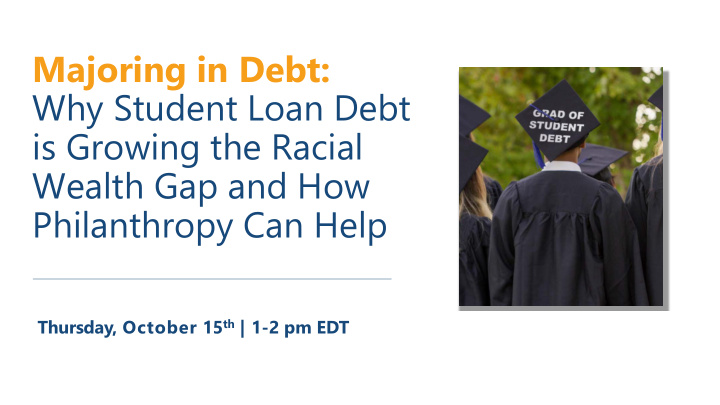



Majoring in Debt: Why Student Loan Debt is Growing the Racial Wealth Gap and How Philanthropy Can Help Thursday, October 15 th | 1-2 pm EDT
Thank you to our Brief sponsors: AssetFunders.org #AssetFunders
SPEAKERS VELVET RAQUAN LISA JENNY ACHILLES BRYANT WEDDERBURN PRICE MODERATOR TRELLIS THE ANNIE E. CASEY ASPEN INSTITNUTE FOUNDATION FOUNDATION FINANCIAL WELLS FARGO SECURITY PROGRAM AssetFunders.org #AssetFunders
WEBINAR CONTROLPANEL PARTICIPATE During the presentation – Type your question in the QUESTIONS BOX to be addressed during discussion breaks or during Q/A AssetFunders.org #AssetFunders
As the only membership organization for grantmakers focused on advancing economic security, the Asset Funders Network connects philanthropic leaders to drive greater impact where it’s needed most. INFORM | CONNECT | INFLUENCE |BUILD AssetFunders.org #AssetFunders
Majoring in Debt: Why Student Loan Debt is Growing the Racial Wealth Gap and How Philanthropy Can Help Raquan Wedderburn, Aspen Institute Financial Security Program Date October 15, 2020
OUR MISSION ● The Aspen Institute Financial Security Program (FSP) mission is to illuminate and solve the most critical financial challenges facing American households and to make financial security for all a top national priority. We aim for nothing less than a more inclusive economy with reduced wealth inequality and shared prosperity. ● We believe that transformational change requires innovation, trust, leadership, and entrepreneurial thinking. FSP galvanizes a diverse set of leaders across the public, private, and nonprofit sectors to solve the most critical financial challenges. We do this through deep, deliberate private and public dialogues and by elevating evidence-based research and solutions that will strengthen the financial health and security of financially vulnerable Americans. 7
U.S. household financial security was at risk even before the pandemic ● Only about 1 in 3 Americans was financially healthy (FHN and CFPB’s Financial Well -Being in America survey) ● 40% of households got by on $33,000 or less (Survey of Consumer Finances) ● 39% of Americans could not come up with $400 without borrowing or selling something (Federal Reserve) ● 23% of households had no emergency savings at all (Bankrate) 8
Agenda ● Overview of student debt challenges ● Principles for student loan solutions ● Solutions overview ● Spotlight on solutions to student debt 9
Student loan debt is now the largest source of nonmortgage consumer debt 10
Rising student loan debt has deep consequences for individuals, communities and the country Student Loan Debt: ● Affects career and life decisions, impeding career advancement and employee retention ○ More than half (53%) of student loan borrowers noted debt as a factor in choosing which career to pursue ○ Nine in 10 college students with student loans are looking for a company that offers a student loan benefit ● Poses risks to the larger economy ○ Research shows it depresses homebuying, auto sales, and other consumption, which could slow economic growth 11
Rising student loan debt has deep consequences for individuals, communities and the country Student Loan Debt: ● Can severely impact short-term financial stability ○ 55% of college graduates with student debt say it forces them to delay saving for emergencies. ● Is a barrier to building long-term financial security ○ Among young student borrowers, those with student loan debt have half the retirement savings at age 30 of those without 12
The “typical” borrower isn’t a stereotype 13
Large loan balances are not the primary problem 14
Principles for Student Debt Solutions Solutions to the student debt crisis should: ● Focus on financial security outcomes ● Build in data collection, evaluation, and publication ● Help those with low balances ● Address the true circumstances of today’s students ● Prioritize equity ● Provide options for noncompleters 15
Solutions for Individual Borrowers We outline opportunities for innovative investment in: ● Access to tools to optimize loan decision-making and management ● Matching programs to reward and accelerate loan repayment ● Legal services to ensure that borrowers facing debt collection litigation are fairly represented ● Individual loan cancellation 16
Spotlight: Student Loan Debt Repayment Assistance A growing trend in workplace benefits is for employers to match employees’ student loan repayment in different ways. ● Example: ○ Medical device manufacturer, Abbott makes a retirement plan contribution on behalf of an employee who is meeting a specified threshold of student loan debt repayment, thus helping the employee save for the future while paying down debt. ● Role for philanthropy: ○ Funders can partner with employers to finance both the facilitation and management of the program as well as the critical matching dollars. ○ Funders can also consider underwriting rigorous evaluation of these programs. 17
Solutions for Systems Change The range of investments include: ● Creation of and access to data from innovative government-facilitated pilot programs ● Continued research on the micro-and macro-level impacts of student loan debt ● Support for policy advocacy to advance major solutions 18
Spotlight: Re-enrollment Programs Re-enrollment programs provide pathways to postsecondary completion to noncompleters, often paired with some amount of debt forgiveness to increase incentives for re-enrollment. ● Example: ○ Warrior Way Back program enables students who dropped out of Wayne State University with outstanding debt to re-enroll. Additionally, the university writes off up to $1,500 — roughly the cost of one class — for all participants of the program. ● Role of philanthropy: ○ Funders can support the development of more innovative programs as well as underwrite critical program evaluation research. 19
THANK YOU FOLLOW US: @AspenFSP Newsletter Bit.ly/aspenfsp/newsletter
Q & A CONTROL PANEL QUESTIONS Click the QUESTIONS box to share a question for the presenters. VELVET RAQUAN LISA JENNY ACHILLES BRYANT WEDDERBURN PRICE MODERATOR TRELLIS THE ANNIE E. CASEY ASPEN INSTITNUTE FOUNDATION FOUNDATION FINANCIAL WELLS FARGO SECURITY PROGRAM AssetFunders.org #AssetFunders
Thank you for attending today’s Asset Funders Network presentation PLEASE FILL OUT OUR SURVEY `` The survey will pop up on your screen momentarily and will also be sent to you via email WE VALUE YOUR TIME, AND YOUR RESPONSES WILLINFORM OUR FUTURE PLANNING AssetFunders.org #AssetFunders 39
Recommend
More recommend